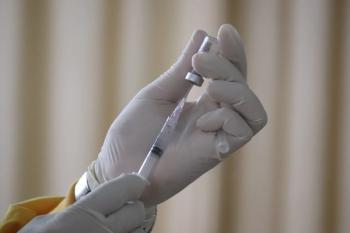
The Yin and Yang of Ceftolozane-Tazobactam Resistance Against Multidrug-Resistant Pseudomonas aeruginosa
Rates of hospital-onset multidrug-resistant P aeruginosa infections have increased significantly in recent years.
Multidrug-resistant (MDR) Pseudomonas aeruginosa is a major public health threat. Rates of hospital-onset MDR P aeruginosa infections increased 32% from 2019 to 2020.1 P aeruginosa exhibits inherent and acquired mechanisms of resistance, including an impermeable outer membrane, repression or inactivation of the porin oprD, upregulation of efflux pumps, increased production of chromosomal AmpC β-lactamase, and the presence of other antibiotic-inactivating enzymes.2-7 In fact, “difficult to treat” resistance (DTR) phenotypes are commonly encountered in clinical practice and are defined as nonsusceptibility to traditional treatment options, including all β-lactams and fluoroquinolones.8
Current guidance from the Infectious Diseases Society of America for the management of serious infections due to DTR P aeruginosa is monotherapy with either ceftolozane-tazobactam, ceftazidime-avibactam, or imipenem-relebactam, with cefiderocol as an alternative.9 The European Society of Clinical Microbiology and Infectious Diseases recommends monotherapy with ceftolozane-tazobactam, but not with imipenem-relebactam, ceftazidime-avibactam or cefiderocol due to a lack of clinical evidence.10
Ceftolozane demonstrates excellent in vitro activity against DTR P aeruginosa and does not require a β-lactamase inhibitor to restore activity.9 Ceftolozane is an oxyimino-cephalosporin that is structurally similar to ceftazidime but is more potent in vitro. Ceftolozane is unique because it is a potent PBP3 inhibitor and has greater than 2-fold higher affinities for all essential penicillin-binding proteins in P aeruginosa compared with ceftazidime.11 Moreover, ceftolozane has low affinity for PBP4, which is a known trap target for β-lactams connected to AmpC induction.12
Ceftolozane is also stable against hydrolysis from chromosomal AmpC β-lactamases, also known as Pseudomonas-derived cephalosporinase (PDC).11,13 This stability is the result of the substitution of a pyrazole side chain on the 3-position of the cephem ring that provides steric hindrance between ceftolozane and the gate to the PDC active-site binding pocket and increased permeability through the outer cell membrane.14,15 The activity of ceftolozane is not affected by efflux pumps or inactivation of oprD.13
Combining ceftolozane with tazobactam does not extend activity against DTR P aeruginosa. Rather, tazobactam inhibits some class A extended-spectrum β-lactamases and susceptible class C β-lactamases (eg, CMY) but not class A, B, or D carbapenemases.16-19 By comparison, avibactam and relebactam are potent inhibitors of most class A and C β-lactamases and are capable of restoring the in vitro activity of ceftazidime and imipenem, respectively, against DTR P aeruginosa.20,21
CLINICAL EXPERIENCE TREATING MDR P AERUGINOSA INFECTIONS
Four randomized, controlled trials have assessed the efficacy of ceftolozane-tazobactam vs other antibiotics for treatment of complicated urinary tract infection, complicated intra-abdominal infection, and hospital-acquired or ventilator-associated bacterial pneumonia.22-25 Across all 4 studies, however, few patients infected by MDR and DTR P aeruginosa have been evaluated. Thus, real-world clinical data have been essential in assessing the efficacy of ceftolozane-tazobactam compared with traditional antipseudomonal regimens used to treat MDR P aeruginosa infections.
Clinical outcomes were evaluated in a retrospective, multicenter cohort study that compared ceftolozane-tazobactam with either a polymyxin or an aminoglycoside-based regimen as definitive therapy for infections due to MDR/extensively drug-resistant P aeruginosa (52% of participants had ventilator-associated bacterial pneumonia). The receipt of ceftolozane-tazobactam was independently associated with clinical cure; the number needed to treat for a clinical cure was 5. Ceftolozane-tazobactam was also found to be protective against acute kidney injury.26
Five randomized, controlled trials have assessed the efficacy of ceftazidime-avibactam vs traditional antipseudomonal agents in the treatment of complicated urinary tract infection, complicated intra-abdominal infection, and nosocomial pneumonia including ventilator-associated pneumonia.27-31 In a pooled analysis of patients with MDR P aeruginosa infections who received ceftazidime-avibactam vs best available therapy (mostly carbapenems), clinical responses were similar, at 57% and 54%, respectively; however, only 66% of isolates were susceptible to ceftazidime-avibactam.32 There is even less clinical experience with imipenem-relebactam and cefiderocol.
Taken together, there remains an overall paucity of comparative clinical evidence for the management of carbapenem-resistant P aeruginosa.
MECHANISMS OF RESISTANCE TO CEFTOLOZANE-TAZOBACTAM AND CROSS-RESISTANCE TO OTHER β-LACTAMS
The development of resistance to each of the previously mentioned agents (like other β-lactams) was reported shortly after FDA approval.
Ceftolozane-tazobactam resistance is most commonly mediated through structural alterations in PDC, a chromosomally encoded class C β-lactamase in P aeruginosa.33 Amino acid substitutions, insertions, and deletions in PDC have been reported and likely facilitate more efficient hydrolysis of ceftolozane.16, 33-40 Specific modifications typically occur in or bordering a region of PDC known as the Ω-loop. The Ω-loop functions to form the floor of the active site in PDC, which binds to the R1 group of β-lactam molecules and determines substrate specificity.41 Amino acid substitutions within the Ω-loop result in widening of the active site to better accommodate the bulky R2 group of ceftolozane, facilitating hydrolysis.33,40
A wider binding pocket also accommodates ceftazidime better.42 In fact, enzyme kinetics of common PDC mutations (E247K, G183D, T96I, and ΔG229-E247) demonstrate greater catalytic efficiencies to both ceftolozane and ceftazidime compared with wild-type PDC. The same PDC mutations further showed decreased affinity for avibactam, reducing PDC’s susceptibility to inhibition by avibactam.43
Other mechanisms may play a complementary role in ceftolozane-tazobactam resistance, which includes overexpression of PDC. Derepression of PDC can result from mutations in the genes involved in AmpC regulation, namely ampR, ampG, ampD, and dacB.33, 40 Less common mechanisms that have been reported include mutations in the DNA polymerase subunits gama and tau or ftsI (which encodes PBP3).42,44,45 Reported rates of treatment-emergent resistance to ceftolozane-tazobactam range from 3% to 50% across observational studies.37,42,46-48 Definitions of resistance have varied across studies.
In one study, resistance was defined as a 4-fold or greater ceftolozane-tazobactam minimum inhibitory concentration (MIC) increase against P aeruginosa isolates collected after 72 or more hours of treatment. Isolates from 14 of 28 patients met the study definition after a median of 15 days of therapy.41 Such cases were more likely to have inadequate source control and less likely to receive ceftolozane-tazobactam as an extended 3-hour infusion compared with control patients whose isolates did not evolve resistance. Common mutations were identified in ampC, ampR, DNA polymerase subunits gama and tau, and ftsI. Notably, 86% of isolates showed high-level cross-resistance to ceftazidime-avibactam without prior ceftazidime-avibactam exposure.41
In a study by Haidar et al, ceftolozane-tazobactam resistance was defined as a MIC greater than or equal to 16 μg/mL. Three of 21 patients (14%) developed ceftolozane-tazobactam resistance as early as 8 days into treatment. Whole-genome sequence analyses demonstrated mutations in the ampC-ampR region of resistant isolates.47
In a Spanish study, ceftolozane-tazobactam resistance (MIC ≥ 32 μg/mL) developed in 8 of 58 patients (14%). In 6 of 8 cases, resistance was due to structural modifications in AmpC. Interestingly, all 6 cases were associated with baseline isolates that harbored preexisting mutations in the AmpC repressor gene, ampR. In the other 2 cases, mutations in OXA-10 were identified. Overall, 88% of cases were associated with cross-resistance to ceftazidime-avibactam.37,45
Cross-resistance between ceftolozane-tazobactam and other novel β-lactams has also been reported. Cefiderocol is a siderophore cephalosporin that demonstrates excellent in vitro activity against DTR P aeruginosa.49 Interestingly, Streling et al described a P aeruginosa isolate that developed nonsusceptibility to cefiderocol after 14 days of ceftolozane-tazobactam treatment without cefiderocol exposure. Mutations in PDC were associated with ceftolozane-tazobactam resistance, and mutations in PiuD and PirA (TonB-dependent receptors) were associated with elevated MICs to cefiderocol.50,51
TREATMENT OF CEFTOLOZANE-TAZOBACTAM–RESISTANT P AERUGINOSA IN CLINICAL PRACTICE
Familiarity of resistance mechanisms is essential in selecting the most appropriate treatment when ceftolozane-tazobactam resistance is identified. In some cases, metallo-β-lactamase (MBL) genes may be present, which manifest in resistance to ceftolozane-tazobactam, ceftazidime-avibactam, and imipenem-relebactam.52 MBLs can hydrolyze all β-lactams except aztreonam and are not inhibited by novel β-lactamase inhibitors. Additionally, MBL-producing P aeruginosa infections have been associated with more rapid onset of illness and faster progression to death compared with non–MBL-producing P aeruginosa infections.53
Cefiderocol employs a “Trojan horse” strategy by exploiting the bacterial iron siderophore uptake system to allow active transport across the bacterial outer membrane and is stable against MBL-mediated hydrolysis.54-56 A post hoc analysis of 2 randomized controlled trials (CREDIBLE-CR and APEKS-NP) highlighted the role of cefiderocol in treating infections caused by MBL-producing pathogens, with 41% (14/34) of patients infected with MBL-producing nonfermenting species like P aeruginosa.56-58 Cefiderocol led to numerically higher clinical cure and microbiological eradication rates compared with best available therapy in patients with nosocomial pneumonia, bloodstream infection/sepsis, or complicated urinary tract infections. These outcomes were consistent across species and cefiderocol MIC values up to 4 μg/ mL.57 Local epidemiology and rates of MBL should be known to assist in therapeutic decision-making.
In a patient with prior treatment of a ceftolozane-tazobactam–susceptible P aeruginosa isolate, it would be important to consider the possibility of treatment-emergent resistance and cross-resistance to ceftazidime-avibactam. Fortunately, other β-lactam antibiotics may demonstrate collateral susceptibility in these situations. In a study by Rubio et al, in vitro susceptibility of MDR P aeruginosa isolates was assessed before and after the development of resistance to ceftolozane-tazobactam (median duration of therapy = 16 days). AmpC mutations were identified in 79% of paired isolates before and after ceftolozane-tazobactam treatment. Postexposure isolates with AmpC mutations were more susceptible to imipenem-relebactam, piperacillin-tazobactam, and imipenem by 2-, 4-, and 8-fold, respectively, vs baseline isolates. Sixty-three percent of all postexposure isolates were susceptible to imipenem-relebactam, including 81% of isolates with treatment-emergent mutations in AmpC.59
Similar findings were observed by Díaz- Cañestro et al in a study of 58 patients treated with ceftolozane-tazobactam, 8 of whom developed treatment-emergent resistance.46 It is proposed that the widening of the substrate binding site that occurs in AmpC structural mutations allows imipenem to rotate its 6α-hydroxyethyl side chain away from the point of hydrolytic attack, translating into increased carbapenem susceptibility.60-62 In a ceftolozane-tazobactam-resistant P aeruginosa isolate, imipenem-relebactam would be preferred vs imipenem because the addition of relebactam would also combat AmpC hyperproduction.38 Cefiderocol may be a consideration in these scenarios as well; however, cross-resistance has been described.49,50
In general, in vitro susceptibility testing should always be performed whenever possible to guide decision-making against MDR/DTR/extensively drug-resistant P aeruginosa given the complexity of the underlying mechanisms of resistance. Comparative effectiveness studies are also notably lacking for the novel antipseudomonal agents. Thus, understanding these mechanisms and interplay of β-lactam resistance can be vital when faced with selecting treatment in these challenging clinical scenarios.
References
1.CDC. COVID-19: U.S. Impact on Antimicrobial Resistance, Special Report 2022. US Department of Health and Human Services, CDC; 2022. doi:10.15620/cdc:117915
2.Lister PD, Wolter DJ, Hanson ND. Antibacterial-resistant Pseudomonas aeruginosa: clinical impact and complex regulation of chromosomally encoded resistance mechanisms. Clin Microbi
1.CDC. COVID-19: U.S. Impact on Antimicrobial Resistance, Special Report 2022. US Department of Health and Human Services, CDC; 2022. doi:10.15620/cdc:117915
2.Lister PD, Wolter DJ, Hanson ND. Antibacterial-resistant Pseudomonas aeruginosa: clinical impact and complex regulation of chromosomally encoded resistance mechanisms. Clin Microbiol Rev. 2009;22(4):582-610. doi:10.1128/CMR.00040-09
3.Jones RN, Deshpande LM, Bell JM, et al. Evaluation of the contemporary occurrence rates of metallo-beta-lactamases in multidrug-resistant gram-negative bacilli in Japan: report from the SENTRY Antimicrobial Surveillance Program (1998-2002). Diagn Microbiol Infect Dis. 2004;49(4):289-294. doi:10.1016/j.diagmicrobio.2004.04.007
4.Livermore DM. Of Pseudomonas, porins, pumps and carbapenems. J Antimicrob Chemother. 2001;47(3):247-250. doi:10.1093/jac/47.3.247
5.Livermore DM. Multiple mechanisms of antimicrobial resistance in Pseudomonas aeruginosa: our worst nightmare? Clin Infect Dis. 2002;34(5):634-640. doi:10.1086/338782
6.Mesaros N, Nordmann P, Plésiat P, et al. Pseudomonas aeruginosa: resistance and therapeutic options at the turn of the new millennium. Clin Microbiol Infect. 2007;13(6):560-578. doi:10.1111/j.1469-0691.2007.01681.x
7.Hancock RE. Resistance mechanisms in Pseudomonas aeruginosa and other nonfermentative gram-negative bacteria. Clin Infect Dis. 1998;27(suppl 1):S93-S99. doi:10.1086/514909
8.Kadri SS, Adjemian J, Lai YL, et al; National Institutes of Health Antimicrobial Resistance Outcomes Research Initiative (NIH-ARORI). Difficult-to-treat resistance in gram-negative bacteremia at 173 US hospitals: retrospective cohort analysis of prevalence, predictors, and outcome of resistance to all first-line agents. Clin Infect Dis. 2018;67(12):1803-1814. doi:10.1093/cid/ciy378
9.IDSA guidance on the treatment of antimicrobial-resistant gram-negative infections: version 1.0. Infectious Diseases Society of America. March 7, 2022. Accessed May 4, 2023. https://www.idsociety.org/practice-guideline/amr-guidance/
10.Paul M, Carrara E, Retamar P, et al. European Society of Clinical Microbiology and Infectious Diseases (ESCMID) guidelines for the treatment of infections caused by multidrug-resistant gram-negative bacilli (endorsed by European society of intensive care medicine). Clin Microbiol Infect. 2022;28(4):521-547. doi:10.1016/j.cmi.2021.11.025
11.Moyá B, Zamorano L, Juan C, Ge Y, Oliver A. Affinity of the new cephalosporin CXA-101 to penicillin-binding proteins of Pseudomonas aeruginosa. Antimicrob Agents Chemother. 2010;54(9):3933-3937. doi:10.1128/AAC.00296-10
12.Moya B, Dötsch A, Juan C, et al. Beta-lactam resistance response triggered by inactivation of a nonessential penicillin-binding protein. PLoS Pathog. 2009;5(3):e1000353. doi:10.1371/journal.ppat.1000353
13.Takeda S, Nakai T, Wakai Y, Ikeda F, Hatano K. In vitro and in vivo activities of a new cephalosporin, FR264205, against Pseudomonas aeruginosa. Antimicrob Agents Chemother. 2007;51(3):826-830. doi:10.1128/AAC.00860-06
14.Toda A, Ohki H, Yamanaka T, et al. Synthesis and SAR of novel parenteral anti-pseudomonal cephalosporins: discovery of FR264205. Bioorg Med Chem Lett. 2008;18(17):4849-4852. doi:10.1016/j.bmcl.2008.07.085
15.Candel FJ, González Del Castillo J, Julián Jiménez A, Matesanz M. Ceftolozane-tazobactam in nosocomial pneumonia. Rev Esp Quimioter. 2022;35(suppl 1):35-39. doi:10.37201/req/s01.08.2022
16.Yahav D, Giske CG, Grāmatniece A, Abodakpi H, Tam VH, Leibovici L. New β-lactam-β-lactamase inhibitor combinations. Clin Microbiol Rev. 2020;34(1):e00115-e00120. doi:10.1128/CMR.00115-20
17.Rodríguez-Martínez JM, Poirel L, Nordmann P. Extended-spectrum cephalosporinases in Pseudomonas aeruginosa. Antimicrob Agents Chemother. 2009;53(5):1766-1771. doi:10.1128/AAC.01410-08
18.Livermore DM, Mushtaq S, Ge Y. Chequerboard titration of cephalosporin CXA-101 (FR264205) and tazobactam versus beta-lactamase-producing Enterobacteriaceae. J Antimicrob Chemother. 2010;65(9):1972-1974. doi:10.1093/jac/dkq248
19.Cho JC, Fiorenza MA, Estrada SJ. Ceftolozane/tazobactam: a novel cephalosporin/β-lactamase inhibitor combination. Pharmacotherapy. 2015;35(7):701-715. doi:10.1002/phar.1609
20.Sader HS, Castanheira M, Shortridge D, Mendes RE, Flamm RK. Antimicrobial activity of ceftazidime-avibactam tested against multidrug-resistant Enterobacteriaceae and Pseudomonas aeruginosa isolates from U.S. medical centers, 2013 to 2016. Antimicrob Agents Chemother. 2017;61(11):e01045-e01117. doi:10.1128/AAC.01045-17
21.Barnes MD, Taracila MA, Rutter JD, et al. Deciphering the evolution of cephalosporin resistance to ceftolozane-tazobactam in Pseudomonas aeruginosa. mBio. 2018;9(6):e02085-e02118. doi:10.1128/mBio.02085-18
22.Wagenlehner FM, Umeh O, Steenbergen J, Yuan G, Darouiche RO. Ceftolozane-tazobactam compared with levofloxacin in the treatment of complicated urinary-tract infections, including pyelonephritis: a randomised, double-blind, phase 3 trial (ASPECT-cUTI). Lancet. 2015;385(9981):1949-1956. doi:10.1016/S0140-6736(14)62220-0
23.Kollef MH, Nováček M, Kivistik Ü, et al. Ceftolozane-tazobactam versus meropenem for treatment of nosocomial pneumonia (ASPECT-NP): a randomised, controlled, double-blind, phase 3, non-inferiority trial. Lancet Infect Dis. 2019;19(12):1299-1311. doi:10.1016/S1473-3099(19)30403-7
24.Lucasti C, Hershberger E, Miller B, et al. Multicenter, double-blind, randomized, phase II trial to assess the safety and efficacy of ceftolozane-tazobactam plus metronidazole compared with meropenem in adult patients with complicated intra-abdominal infections. Antimicrob Agents Chemother. 2014;58(9):5350-5357. doi:10.1128/AAC.00049-14
25.Solomkin J, Hershberger E, Miller B, et al. Ceftolozane/tazobactam plus metronidazole for complicated intra-abdominal infections in an era of multidrug resistance: results from a randomized, double-blind, phase 3 trial (ASPECT-cIAI). Clin Infect Dis. 2015;60(10):1462-1471. doi:10.1093/cid/civ097
26.Pogue JM, Kaye KS, Veve MP, et al. Ceftolozane/tazobactam vs polymyxin or aminoglycoside-based regimens for the treatment of drug-resistant Pseudomonas aeruginosa. Clin Infect Dis. 2020;71(2):304-310. doi:10.1093/cid/ciz816
27.Vena A, Giacobbe DR, Castaldo N, et al. Clinical experience with ceftazidime-avibactam for the treatment of infections due to multidrug-resistant gram-negative bacteria other than carbapenem-resistant Enterobacterales. Antibiotics (Basel). 2020;9(2):71. doi:10.3390/antibiotics9020071
28.Torres A, Zhong N, Pachl J, et al. Ceftazidime-avibactam versus meropenem in nosocomial pneumonia, including ventilator-associated pneumonia (REPROVE): a randomised, double-blind, phase 3 non-inferiority trial. Lancet Infect Dis. 2018;18(3):285-295. doi:10.1016/S1473-3099(17)30747-8
29.Mazuski JE, Gasink LB, Armstrong J, et al. Efficacy and safety of ceftazidime-avibactam plus metronidazole versus meropenem in the treatment of complicated intra-abdominal infection: results from a randomized, controlled, double-blind, phase 3 program. Clin Infect Dis. 2016;62(11):1380-1389. doi:10.1093/cid/ciw133
30.Wagenlehner FM, Sobel JD, Newell P, et al. Ceftazidime-avibactam versus doripenem for the treatment of complicated urinary tract infections, including acute pyelonephritis: RECAPTURE, a phase 3 randomized trial program. Clin Infect Dis. 2016;63(6):754-762. doi:10.1093/cid/ciw378
31.Qin X, Tran BG, Kim MJ, et al. A randomised, double-blind, phase 3 study comparing the efficacy and safety of ceftazidime/avibactam plus metronidazole versus meropenem for complicated intra-abdominal infections in hospitalised adults in Asia. Int J Antimicrob Agents. 2017;49(5):579-588. doi:10.1016/j.ijantimicag.2017.01.010
32. Stone GG, Newell P, Gasink LB, et al. Clinical activity of ceftazidime/avibactam against MDR Enterobacteriaceae and Pseudomonas aeruginosa: pooled data from the ceftazidime/avibactam Phase III clinical trial programme. J Antimicrob Chemother. 2018;73(9):2519-2523. doi:10.1093/jac/dky204
33.Papp-Wallace KM, Mack AR, Taracila MA, Bonomo RA. Resistance to novel β-lactam-β-lactamase inhibitor combinations: the “price of progress.” Infect Dis Clin North Am. 2020;34(4):773-819. doi:10.1016/j.idc.2020.05.001
34.Bankevich A, Nurk S, Antipov D, et al. SPAdes: a new genome assembly algorithm and its applications to single-cell sequencing. J Comput Biol. 2012;19(5):455-477. doi:10.1089/cmb.2012.0021
35.Skoglund E, Abodakpi H, Rios R, et al. In vivo resistance to ceftolozane/tazobactam in Pseudomonas aeruginosa arising by AmpC- and non-AmpC-mediated pathways. Case Rep Infect Dis. 2018;2018:9095203. doi:10.1155/2018/9095203
36.Zasowski EJ, Rybak JM, Rybak MJ. The β-lactams strike back: ceftazidime-avibactam. Pharmacotherapy. 2015;35(8):755-770. doi:10.1002/phar.1622
37.Fraile-Ribot PA, Cabot G, Mulet X, et al. Mechanisms leading to in vivo ceftolozane/tazobactam resistance development during the treatment of infections caused by MDR Pseudomonas aeruginosa. J Antimicrob Chemother. 2018;73(3):658-663. doi:10.1093/jac/dkx424
38.Fraile-Ribot PA, Zamorano L, Orellana R, et al; GEMARA-SEIMC/REIPI Pseudomonas Study Group. Activity of imipenem-relebactam against a large collection of Pseudomonas aeruginosa clinical isolates and isogenic β-lactam-resistant mutants. Antimicrob Agents Chemother. 2020;64(2):e02165-e02219. doi:10.1128/AAC.02165-19
39.Zamudio R, Hijazi K, Joshi C, Aitken E, Oggioni MR, Gould IM. Phylogenetic analysis of resistance to ceftazidime/avibactam, ceftolozane/tazobactam and carbapenems in piperacillin/tazobactam-resistant Pseudomonas aeruginosa from cystic fibrosis patients. Int J Antimicrob Agents. 2019;53(6):774-780. doi:10.1016/j.ijantimicag.2019.02.022
40.Cabot G, Bruchmann S, Mulet X, et al. Pseudomonas aeruginosa ceftolozane-tazobactam resistance development requires multiple mutations leading to overexpression and structural modification of AmpC. Antimicrob Agents Chemother. 2014;58(6):3091-3099. doi:10.1128/AAC.02462-13
41.Jacoby GA. AmpC beta-lactamases. Clin Microbiol Rev. 2009;22(1):161-182, Table of Contents. doi:10.1128/CMR.00036-08
42.Tamma PD, Beisken S, Bergman Y, et al. Modifiable risk factors for the emergence of ceftolozane-tazobactam resistance. Clin Infect Dis. 2021;73(11):e4599-e4606. doi:10.1093/cid/ciaa1306
43.Slater CL, Winogrodzki J, Fraile-Ribot PA, Oliver A, Khajehpour M, Mark BL. Adding insult to injury: mechanistic basis for how AmpC mutations allow Pseudomonas aeruginosa to accelerate cephalosporin hydrolysis and evade avibactam. Antimicrob Agents Chemother. 2020;64(9):e00894-e00920. doi:10.1128/AAC.00894-20
44.Del Barrio-Tofiño E, Zamorano L, Cortes-Lara S, et al; GEMARA-SEIMC/REIPI Pseudomonas study Group. Spanish nationwide survey on Pseudomonas aeruginosa antimicrobial resistance mechanisms and epidemiology. J Antimicrob Chemother. 2019;74(7):1825-1835. doi:10.1093/jac/dkz147
45.Del Barrio-Tofiño E, López-Causapé C, Cabot G, et al. Genomics and susceptibility profiles of extensively drug-resistant Pseudomonas aeruginosa isolates from Spain. Antimicrob Agents Chemother. 2017;61(11):e01589-e01617. doi:10.1128/AAC.01589-17
46.Díaz-Cañestro M, Periañez L, Mulet X, et al. Ceftolozane/tazobactam for the treatment of multidrug resistant Pseudomonas aeruginosa: experience from the Balearic Islands. Eur J Clin Microbiol Infect Dis. 2018;37(11):2191-2200. doi:10.1007/s10096-018-3361-0
47.Haidar G, Philips NJ, Shields RK, et al. Ceftolozane-tazobactam for the treatment of multidrug-resistant Pseudomonas aeruginosa infections: clinical effectiveness and evolution of resistance. Clin Infect Dis. 2017;65(1):110-120. doi:10.1093/cid/cix182
48. Streling AP, Al Obaidi MM, Lainhart WD, et al. Evolution of cefiderocol non-susceptibility in Pseudomonas aeruginosa in a patient without previous exposure to the antibiotic. Clin Infect Dis. 2021;73(11):e4472-e4474. doi:10.1093/cid/ciaa1909
49.Bassetti M, Castaldo N, Cattelan A, et al; CEFTABUSE Study Group. Ceftolozane/tazobactam for the treatment of serious Pseudomonas aeruginosa infections: a multicentre nationwide clinical experience. Int J Antimicrob Agents. 2019;53(4):408-415. doi:10.1016/j.ijantimicag.2018.11.001
50.O’Donnell JN, Bidell MR, Lodise TP. Approach to the treatment of patients with serious multidrug-resistant Pseudomonas aeruginosa infections. Pharmacotherapy. 2020;40(9):952-969. doi:10.1002/phar.2449
51. Streling AP, Al Obaidi MM, Lainhart WD, et al. Evolution of cefiderocol non-susceptibility in Pseudomonas aeruginosa in a patient without previous exposure to the antibiotic. Clin Infect Dis. 2021;73(11):e4472-e4474. doi:10.1093/cid/ciaa1909
52.Simner PJ, Beisken S, Bergman Y, Posch AE, Cosgrove SE, Tamma PD. Cefiderocol activity against clinical Pseudomonas aeruginosa isolates exhibiting ceftolozane-tazobactam resistance. Open Forum Infect Dis. 2021;8(7):ofab311. doi:10.1093/ofid/ofab311
53.Yoon EJ, Jeong SH. Mobile carbapenemase genes in Pseudomonas aeruginosa. Front Microbiol. 2021;12:614058. doi:10.3389/fmicb.2021.614058
54.Lucena A, Dalla Costa LM, Nogueira KS, et al. Nosocomial infections with metallo-beta-lactamase-producing Pseudomonas aeruginosa: molecular epidemiology, risk factors, clinical features and outcomes. J Hosp Infect. 2014;87(4):234-240. doi:10.1016/j.jhin.2014.05.007
55.Ito A, Kohira N, Bouchillon SK, et al. In vitro antimicrobial activity of S-649266, a catechol-substituted siderophore cephalosporin, when tested against non-fermenting gram-negative bacteria . J Antimicrob Chemother. 2016;71(3):670-677. doi:10.1093/jac/dkv402
56.Kohira N, West J, Ito A, et al. In vitro antimicrobial activity of a siderophore cephalosporin, S-649266, against Enterobacteriaceae clinical isolates, including carbapenem-resistant strains. Antimicrob Agents Chemother. 2015;60(2):729-734. doi:10.1128/AAC.01695-15
57.Ito-Horiyama T, Ishii Y, Ito A, et al. Stability of novel siderophore cephalosporin S-649266 against clinically relevant carbapenemases. Antimicrob Agents Chemother. 2016;60(7):4384-4386. doi:10.1128/AAC.03098-15
58.Timsit JF, Paul M, Shields RK, et al. Cefiderocol for the treatment of infections due to metallo-B-lactamase-producing pathogens in the CREDIBLE-CR and APEKS-NP phase 3 randomized studies. Clin Infect Dis. 2022;75(6):1081-1084. doi:10.1093/cid/ciac078
59.Rubio AM, Kline EG, Jones CE, et al. In Vitro Susceptibility of Multidrug-Resistant Pseudomonas aeruginosa following Treatment-Emergent Resistance to Ceftolozane-Tazobactam. Antimicrob Agents Chemother. 2021;65(6):e00084-21. Published 2021 May 18. doi:10.1128/AAC.00084-21
60.Bassetti M, Echols R, Matsunaga Y, et al. Efficacy and safety of cefiderocol or best available therapy for the treatment of serious infections caused by carbapenem-resistant gram-negative bacteria (CREDIBLE-CR): a randomised, open-label, multicentre, pathogen-focused, descriptive, phase 3 trial. Lancet Infect Dis. 2021;21(2):226-240. doi:10.1016/S1473-3099(20)30796-9
61.Wunderink RG, Matsunaga Y, Ariyasu M, et al. Cefiderocol versus high-dose, extended-infusion meropenem for the treatment of gram-negative nosocomial pneumonia (APEKS-NP): a randomised, double-blind, phase 3, non-inferiority trial. Lancet Infect Dis. 2021;21(2):213-225. doi:10.1016/S1473-3099(20)30731-3
62.Lahiri SD, Walkup GK, Whiteaker JD, et al. Selection and molecular characterization of ceftazidime/avibactam-resistant mutants in Pseudomonas aeruginosa strains containing derepressed AmpC. J Antimicrob Chemother. 2015;70(6):1650-1658. doi:10.1093/jac/dkv004
Newsletter
Stay ahead of emerging infectious disease threats with expert insights and breaking research. Subscribe now to get updates delivered straight to your inbox.

















































































































































































































































































